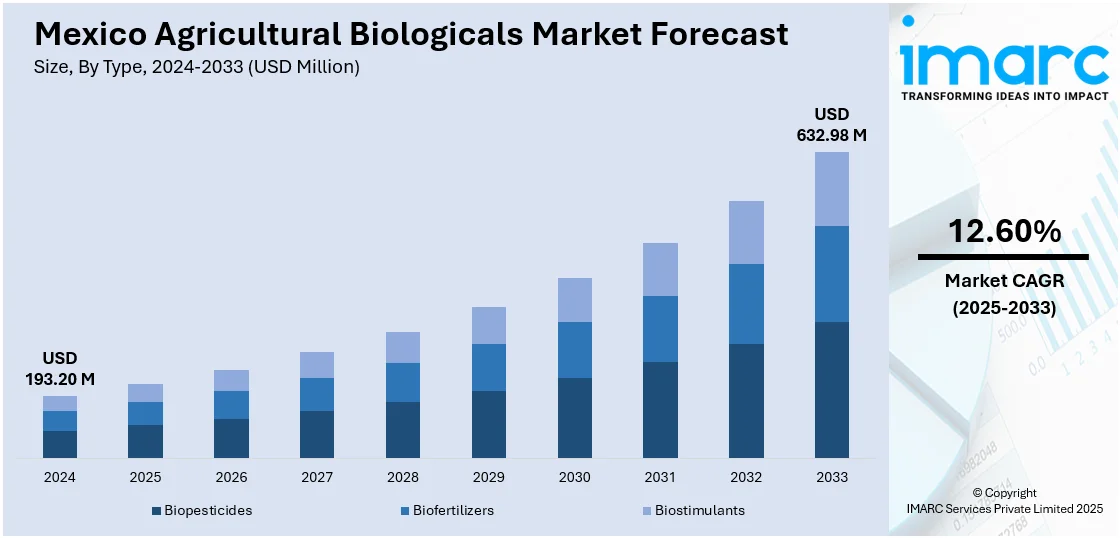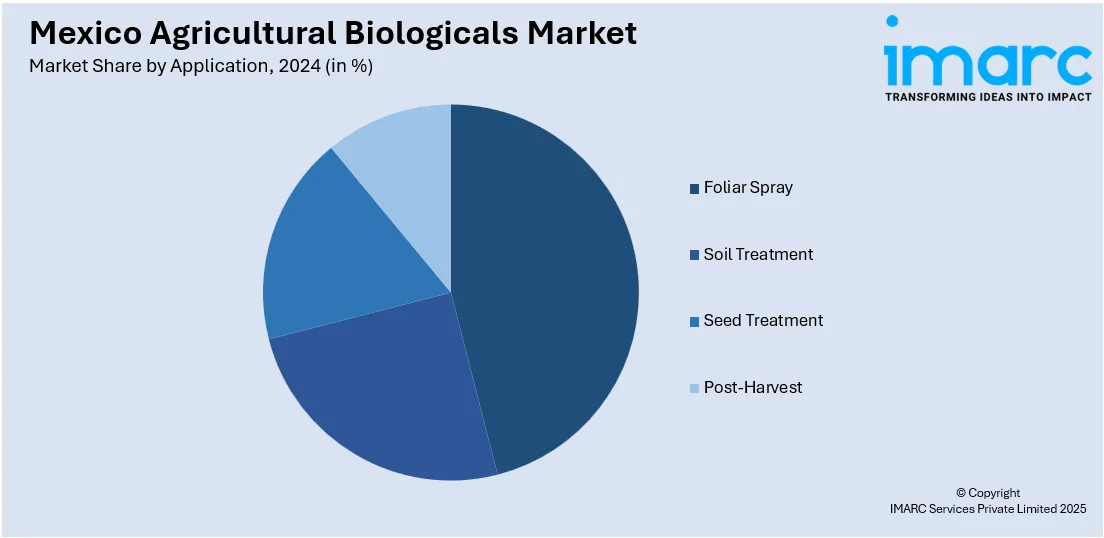
Mexico Agricultural Biologicals Market Size, Share, Trends and Forecast by Type, Source, Crop Type, Application, and Region, 2025-2033
Mexico Agricultural Biologicals Market Overview:
The Mexico agricultural biologicals market size reached USD 193.20 Million in 2024. Looking forward, IMARC Group expects the market to reach USD 632.98 Million by 2033, exhibiting a growth rate (CAGR) of 12.60% during 2025-2033. Mexico agriculture biologicals market is growing steadily with strict controls on pesticide residues, rising organic farming, and government policies for sustainability. Besides this, the uptake of integrated pest management, regulatory needs for export, and consumers demand for chemical-free produce are stimulating the market growth. Apart from this, advancement in microbial formulation, local agritech alliances, focus on crop yield enhancement, small farmer training initiatives, and rising entry by global and local players are boosting the Mexico agricultural biologicals market share.
|
Report Attribute
|
Key Statistics
|
|---|---|
|
Base Year
|
2024 |
|
Forecast Years
|
2025-2033
|
|
Historical Years
|
2019-2024
|
| Market Size in 2024 | USD 193.20 Million |
| Market Forecast in 2033 | USD 632.98 Million |
| Market Growth Rate 2025-2033 | 12.60% |
Mexico Agricultural Biologicals Market Trends:
Pesticide Residue Regulations Tightening
Mexico's agricultural sector is under more stringent national and international standards of pesticide residues, particularly in exports. Major trading countries like the United States and the European Union (EU) have established lower maximum residue levels (MRLs) than in the past. This is compelling Mexican farmers reevaluate crop protection strategies to remain able to access the market. Agricultural biologicals, constituted by biopesticides, biofungicides, and biostimulants, are becoming increasingly important. They have minimal or no residues, making them perfect for export compliance. For instance, in February 2024, Biotor Labs introduced two biopesticides, Trichomax and Klamic, in Mexico. These biofungicides and bionematicides manage soilborne diseases and nematodes, promoting sustainable agricultural practices. Moreover, enforcement in the local market has also gotten tough, with Mexican officials conducting more frequent inspections and pushing for safe use of inputs. This shift is encouraging producers in all vegetable and fruit crops, and high-value crops, to include biologicals in their pest and disease control programs. The tightening of residue legislation is serving as a principal force to push market growth, specifically by Mexican export-based agribusinesses.

Rise in Organic Farming Practices
Mexico has seen steady growth in organic agriculture with local and external demand for organic crops continuing to grow. Organic agriculture in Mexico is most prominent in states such as Oaxaca, Chiapas, and Michoacán, where small- and medium-sized farms predominate. These farms are increasingly adopting biological products because they meet organic certification standards and enhance soil and crop health without the use of synthetic products. Export markets, especially the U.S. and Canada, are setting the pace by offering price premiums on organically certified fruits. The government and other non-governmental organizations (NGOs) are also supporting organic farming with subsidies, capacity building, and certification support. Biologicals help address most of the problems in organic farming like pest management and nutrition without violating organic principles.
Government Support for Sustainable Agriculture
The Mexican government is actively promoting sustainable agriculture as part of its broader environmental and food security goals. Programs such as “Producción para el Bienestar” and collaborations with international development agencies are encouraging farmers to reduce dependence on chemical inputs. These initiatives offer financial incentives, technical training, and access to alternative crop protection and enhancement methods. Agricultural biologicals are a central component of this shift, providing a safer and more environmentally responsible option for managing pests and improving crop yield. For example, in October 2023, Futureco Bioscience diversified its operations by opening a subsidiary in Mexico, launching its bio stimulant and biocontrol products, consolidating its presence in the country's agricultural market. Furthermore, government-backed demonstration plots and pilot programs are showing positive outcomes, especially in staple crops like maize and beans. The promotion of sustainable practices is also tied to rural development strategies aimed at improving incomes and resilience among smallholder farmers, which is further driving the Mexico agricultural biologicals market growth.
Mexico Agricultural Biologicals Market Segmentation:
IMARC Group provides an analysis of the key trends in each segment of the market, along with forecasts at the country and regional levels for 2025-2033. Our report has categorized the market based on type, source, crop type, and application.
Type Insights:
- Biopesticides
- Biofertilizers
- Biostimulants
The report has provided a detailed breakup and analysis of the market based on the type. This includes biopesticides, biofertilizers, and biostimulants.
Source Insights:
- Microbials
- Macrobials
- Biochemicals
- Others
A detailed breakup and analysis of the market based on the source have also been provided in the report. This includes microbials, macrobials, biochemicals, and others.
Crop Type Insights:
- Cereals and Grains
- Oilseed and Pulses
- Fruits and Vegetables
- Turf and Ornamentals
- Others
The report has provided a detailed breakup and analysis of the market based on the crop type. This includes cereals and grains, oilseed and pulses, fruits and vegetables, turf and ornamentals, and others.
Application Insights:

- Foliar Spray
- Soil Treatment
- Seed Treatment
- Post-Harvest
A detailed breakup and analysis of the market based on the application have also been provided in the report. This includes foliar spray, soil treatment, seed treatment, and post-harvest.
Regional Insights:
- Northern Mexico
- Central Mexico
- Southern Mexico
- Others
The report has also provided a comprehensive analysis of all the major regional markets, which include Northern Mexico, Central Mexico, Southern Mexico, and others.
Competitive Landscape:
The market research report has also provided a comprehensive analysis of the competitive landscape. Competitive analysis such as market structure, key player positioning, top winning strategies, competitive dashboard, and company evaluation quadrant has been covered in the report. Also, detailed profiles of all major companies have been provided.
Mexico Agricultural Biologicals Market News:
- In April 2024, Planasa opened a new R&D center in Jacona, Michoacán, Mexico, with the mission to create new varieties of berries and improve agricultural biologicals. The center is geared towards strengthening plant resistance and adaptability to regional conditions, sustainable agriculture, and the development of biological products for berry cultivation.
Mexico Agricultural Biologicals Market Report Coverage:
| Report Features | Details |
|---|---|
| Base Year of the Analysis | 2024 |
| Historical Period | 2019-2024 |
| Forecast Period | 2025-2033 |
| Units | Million USD |
| Scope of the Report |
Exploration of Historical Trends and Market Outlook, Industry Catalysts and Challenges, Segment-Wise Historical and Future Market Assessment:
|
| Types Covered | Biopesticides, Biofertilizers, Biostimulants |
| Sources Covered | Microbials, Macrobials, Biochemicals, Others |
| Crop Types Covered | Cereals and Grains, Oilseed and Pulses, Fruits and Vegetables, Turf and Ornamentals, Others |
| Applications Covered | Foliar Spray, Soil Treatment, Seed Treatment, Post-Harvest |
| Regions Covered | Northern Mexico, Central Mexico, Southern Mexico, Others |
| Customization Scope | 10% Free Customization |
| Post-Sale Analyst Support | 10-12 Weeks |
| Delivery Format | PDF and Excel through Email (We can also provide the editable version of the report in PPT/Word format on special request) |
Key Questions Answered in This Report:
- How has the Mexico agricultural biologicals market performed so far and how will it perform in the coming years?
- What is the breakup of the Mexico agricultural biologicals market on the basis of type?
- What is the breakup of the Mexico agricultural biologicals market on the basis of source?
- What is the breakup of the Mexico agricultural biologicals market on the basis of crop type?
- What is the breakup of the Mexico agricultural biologicals market on the basis of application?
- What is the breakup of the Mexico agricultural biologicals market on the basis of region?
- What are the various stages in the value chain of the Mexico agricultural biologicals market?
- What are the key driving factors and challenges in the Mexico agricultural biologicals market?
- What is the structure of the Mexico agricultural biologicals market and who are the key players?
- What is the degree of competition in the Mexico agricultural biologicals market?
Key Benefits for Stakeholders:
- IMARC’s industry report offers a comprehensive quantitative analysis of various market segments, historical and current market trends, market forecasts, and dynamics of the Mexico agricultural biologicals market from 2019-2033.
- The research report provides the latest information on the market drivers, challenges, and opportunities in the Mexico agricultural biologicals market.
- Porter's five forces analysis assist stakeholders in assessing the impact of new entrants, competitive rivalry, supplier power, buyer power, and the threat of substitution. It helps stakeholders to analyze the level of competition within the Mexico agricultural biologicals industry and its attractiveness.
- Competitive landscape allows stakeholders to understand their competitive environment and provides an insight into the current positions of key players in the market.
Need more help?
- Speak to our experienced analysts for insights on the current market scenarios.
- Include additional segments and countries to customize the report as per your requirement.
- Gain an unparalleled competitive advantage in your domain by understanding how to utilize the report and positively impacting your operations and revenue.
- For further assistance, please connect with our analysts.
 Request Customization
Request Customization
 Speak to an Analyst
Speak to an Analyst
 Request Brochure
Request Brochure
 Inquire Before Buying
Inquire Before Buying




.webp)




.webp)












